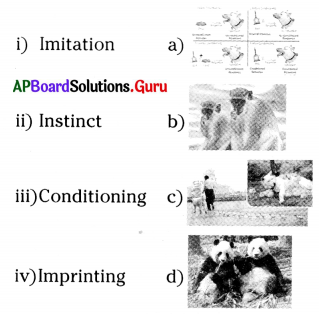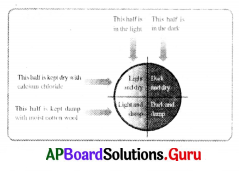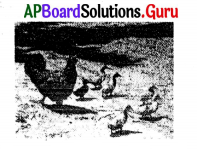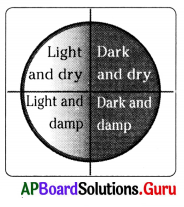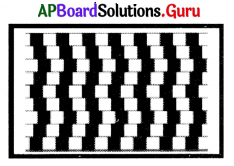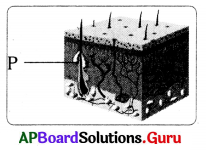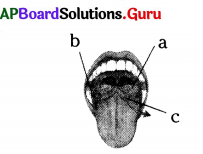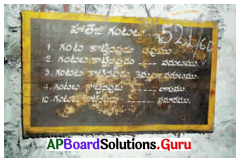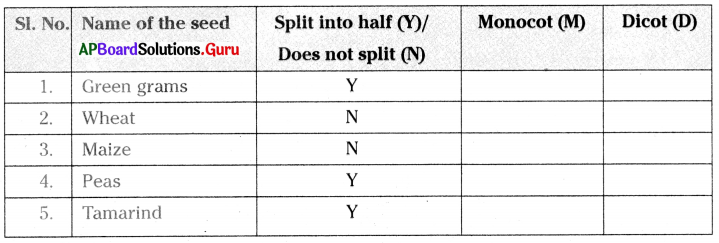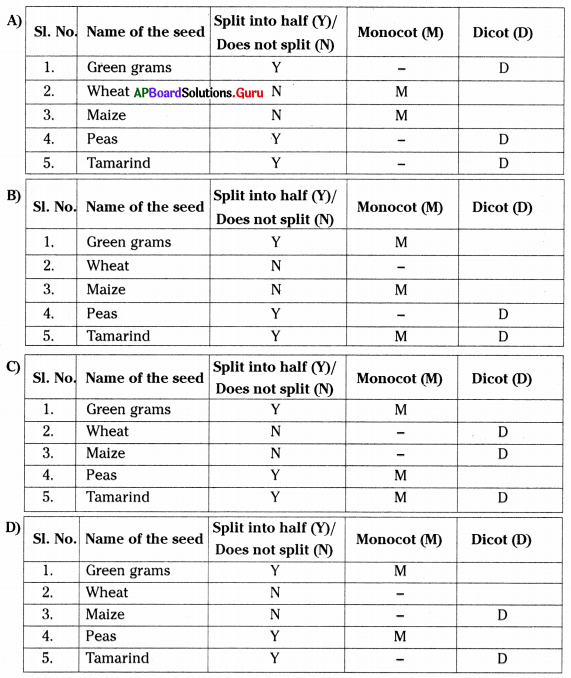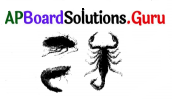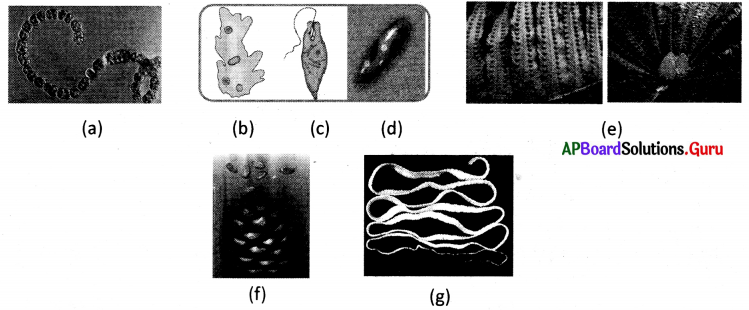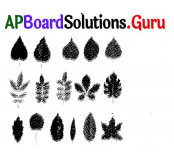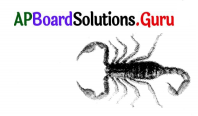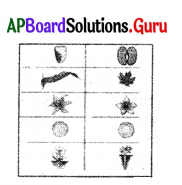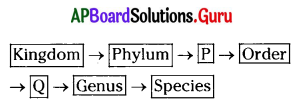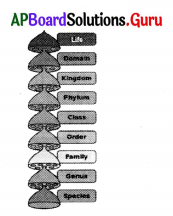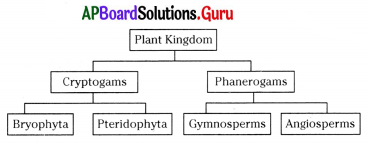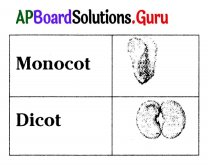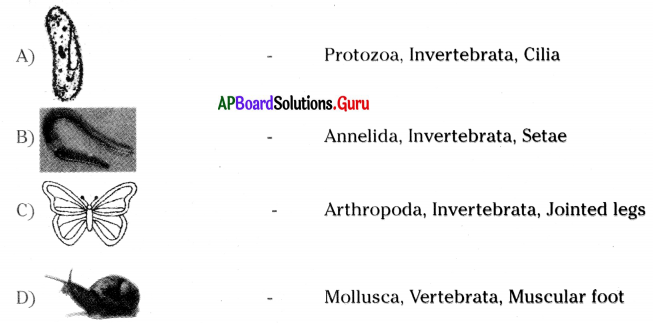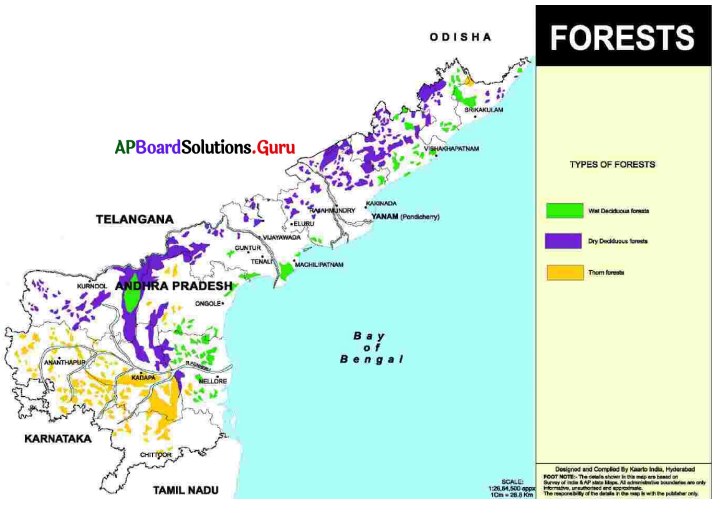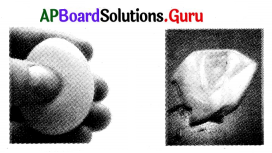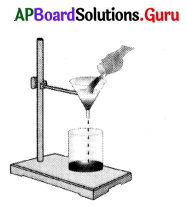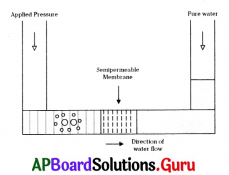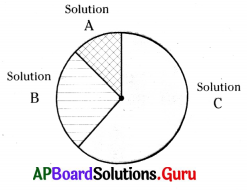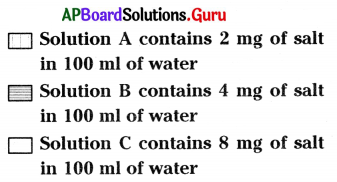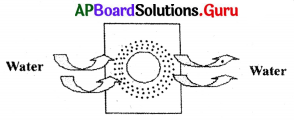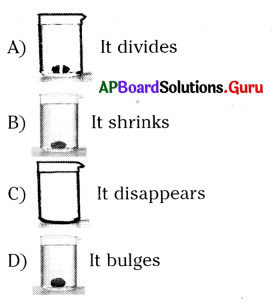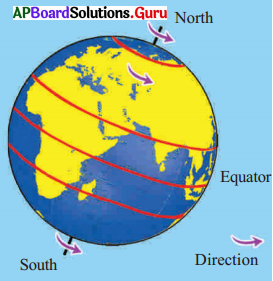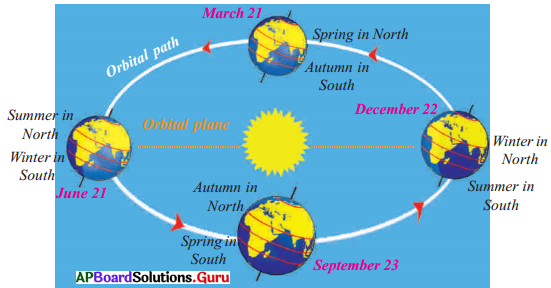Practice the AP 9th Class Biology Bits with Answers Chapter 8 Challenges in Improving Agricultural Products on a regular basis so that you can attempt exams with utmost confidence.
AP State Syllabus 9th Class Biology Bits 8th Lesson Challenges in Improving Agricultural Products with Answers
Choose the correct answers :
Question 1.
The factor responsible for increase in production of a crop
A) Kind of seeds planted
B) Properties of the soil
C) The availability and proper application of irrigation and fertilisers
D) All
Answer:
D) All
Question 2.
We can increase the food production by
A) Increasing the area of cultivated land
B) Developing high yielding varieties.
C) Alternate crops
D) All
Answer:
D) All
![]()
Question 3.
Alternating of crops preserve the
A) Soil fertility
B) High yielding varieties
C) Soil management
D) Crop management
Answer:
A) Soil fertility
Question 4.
Starch is a
A) Fat
B) Carbohydrate
C) Protein
D) Vitamin
Answer:
B) Carbohydrate
Question 5.
100 gms of water react with 200 grams of carbondioxide to form how many grams of carbohydrate ?
A) 280 grams
B) 360 grams
C) 180 grams
D) 380 grams
Answer:
C) 180 grams
Question 6.
Most of the water released by plants, evaporate from the leaves through
A) Epidermis
B) Mesophyll cell
C) Stomata
D) Xylem
Answer:
C) Stomata
Question 7.
This crop require more quantity of water.
A) Paddy
B) Black gram
C) Ground nut
D) Bajra
Answer:
A) Paddy
Question 8.
The irrigation system helps in preserving water wastage
A) Canal irrigation
B) Pond irrigation
C) Drip irrigation
D) None
Answer:
C) Drip irrigation
Question 9.
Identify the macro nutrient.
A) Iron
B) Nitrogen
C) Copper
D) Manganese
Answer:
B) Nitrogen
![]()
Question 10.
Nutrients are added to the soil by
A) Rotating crops
B) Organic manure
C) Chemical fertilizers
D) All
Answer:
D) All
Question 11.
Crops that take lot of nutrients from the soil are
A) Cereals
B) Pulses
C) Tubers
D) All
Answer:
A) Cereals
Question 12.
Leguminous crop gives about how many kg of nitrogen per hectare
A) 150 to 200 kg
B) 50 to 150 kg
C) 100 to 150 kg
D) 25 to 100 kg
Answer:
B) 50 to 150 kg
Question 13.
Blue green algae culture is applied in
A) Potato fields
B) Drumstick field
C) Ground nut fields
D) Paddy field
Answer:
D) Paddy field
Question 14.
Who suggest the type of crop to be grown after observing the field ?
A) Agricultural officer
B) Soil testing technologist
C) Both A and B
D) Village Development Officer
Answer:
C) Both A and B
Question 15.
The main ingredients of Panchagavya are
A) Milk, Curd
B) Ghee, Dung
C) Urine of Cow
D) All the above
Answer:
D) All the above
Question 16.
Long term high yielding capacity of soil depends on
A) Availability of nutrients in the soil
B) Suitable physical, chemical and biological characters of soil
C) Both A and B
D) Rainfall
Answer:
C) Both A and B
![]()
Question 17.
In organic farming farmers
A) Use natural manures
B) Use natural pest controlling methods
C) Practise crop rotation and mixed crop system
D) All
Answer:
D) All
Question 18.
Urea has how much percentage of nitrogen ?
A) 36 %
B) 46 %
C) 56 %
D) 44 %
Answer:
B) 46 %
Question 19.
Insecticides are chemicals used to kill
A) Microorganisms
B) Worm
C) Insects
D) Fungus
Answer:
C) Insects
Question 20.
Pesticides and insecticides are used in large quantities in this district.
A) Guntur
B) Prakasam
C) Nellore
D) A and C
Answer:
D) A and C
Question 21.
Identify the friendly insect.
A) Spider, dragonfly
B) Krisopa, mirids
C) Lady bird beetle
D) All
Answer:
D) All
Question 22.
Bacterium lives in the eggs of stem borer
A) Bacillum
B) Trachoderma
C) Rhizobium
D) Azotobactor
Answer:
B) Trachoderma
Question 23.
Bacteria that destroy some pests is
A) Bacillus Turingenesis
B) Rhizobium
C) Azotobactor
D) Bacillus Pseudomonos
Answer:
A) Bacillus Turingenesis
![]()
Question 24.
After paddy, cultivating black gram prevents
A) Tungro virus on paddy
B) Gram caterpillar
C) Spotted boleworm
D) All
Answer:
A) Tungro virus on paddy
Question 25.
Nitrogen fixing Bacteria
A) Rhizobium
B) Bacillus
C) Micoryza
D) Pencillium
Answer:
A) Rhizobium
Question 26.
Krisopa, lady birds, beetles are the examples of
A) Crop destroyers
B) Friendly insects
C) Crop enemies
D) Insecticides
Answer:
B) Friendly insects
Question 27.
Example of algae as nitrogen fixer
A) Blue green algae
B) Red algae
C) Brown algae
D) Above all
Answer:
A) Blue green algae
Question 28.
Example of phosphorus solubiliser
A) Blue green algae
B) Micorhyza
C) Pencillium
D) Pseudomonas
Answer:
C) Pencillium
Question 29.
The fungi used as biofertilizer
A) Azoto bactor
B) Bacillus
C) Micorhyza
D) Blue green algae
Answer:
C) Micorhyza
Question 30.
Peta and IR – 8 are
A) Sugarcane varieties
B) Orange crop varieties
C) Rice varieties
D) Wheat crops
Answer:
C) Rice varieties
![]()
Question 31.
Example for mixed crop ………………………
A) Groundnut + Sugarcane
B) Sugarcane + Beetle
C) Rice + Groundnut
D) Maize + Red gram
Answer:
D) Maize + Red gram
Question 32.
Find the odd one out.
A) Boran
B) Zinc
C) Copper
D) Sulphur
Answer:
D) Sulphur
Question 33.
Find the odd one out.
A) K
B) Ca
C) Mg
D) Cl
Answer:
D) Cl
Question 34.
Which one of the following nutrients is not available in fertilizers?
A) Iron
B) Calcium
C) Potassium
D) Nitrogen
Answer:
A) Iron
Question 35.
Xanthium and Parthenium are examples of …………………..
A) Weeds
B) Pesticides
C) Fungicides
D) Crop varieties
Answer:
A) Weeds
Question 36.
Which one of the following is raised as food for the livestock ?
A) Millet
B) Sorghum
C) Lenta
D) Sugarcane
Answer:
C) Lenta
Question 37.
The way of incorporating desirable characters into crop varieties is by
A) Hybridisation
B) Crop rotation
C) Intercropping
D) Multiple cropping
Answer:
A) Hybridisation
![]()
Question 38.
NPK ratio in organic fertilizer
A) Above 14%
B) Below 14%
C) Above 40%
D) Below 40%
Answer:
A) Above 14%
Question 39.
Find out the micro nutrient from the following.
A) Boran, Iron, Copper
B) Phosphorus, Potash
C) Potash, Chlorine, Zinc
D) Nitrogen, Zinc, Manganese
Answer:
A) Boran, Iron, Copper
Question 40.
This crop requires very less amount of water.
A) Red gram
B) Sugarcane
C) Wheat
D) Paddy
Answer:
A) Red gram
Question 41.
Identify the weed present in the crop of mirchi.
A) Garika
B) Pulichinta
C) Pogakumalli
D) Varipilla Gaddi
Answer:
B) Pulichinta
Question 42.
This is a nitrogen fixer.
A) Pseudomonas
B) Michorhyza
C) Pencillium
D) Azotobacter
Answer:
D) Azotobacter
Question 43.
The crop that is grown along with cabbage is
A) Sugarcane
B) Maize
C) Groundnut
D) Carrot
Answer:
C) Groundnut
Question 44.
Absorption of CO2 and evaporation of water occurs through ………………….
A) Leaves
B) Roots
C) Stomata
D) Stem
Answer:
C) Stomata
![]()
Question 45.
Identify the mismatched pair from the following.
List – A – List – B
1) Rabi crop – Mustard
2) Kharif crop – Cotton
3) Mixed crop – Sugarcane
A) 1, 2
B) 2, 3
C) 1 only
D) 3 only
Answer:
D) 3 only
Question 46.
Identify the mismatched pair from the
following.
List – A – List – B
1) Dragon fly – Predator of pests
2) Coconut water – Panchagavya
3) Kulthi – Mixed crop
A) 1, 2
B) 2, 3
C) 1 only
D) 3 only
Answer:
D) 3 only
Question 47.
Identify the mismatched pair from the following.
1) Bacteria – Rhyzobium
2) Algae – Bluegreen algae
3) Fungi – Pseudomonas
A) 1, 2
B) 2, 3
C) 2 only
D) 3 only
Answer:
D) 3 only
Question 48.
Identify the mismatched pair from the following.
1) Rice – Wanza
2) Tobacco – Gaddi chamanthi
3) Groundnut – Pogakumalli
A) 1 only
B) 1,2
C) 2,3
D) 3 only
Answer:
C) 2,3
| Name of the Crop | Weeds that grown on crop |
| Paddy | Cynodon dactylon, Digitaria iongi folia, Cyperus rotundus, Eichornia. |
| Groundnut | Leucas aspera, Portulaca oleracea, Cleome sps, Abutilon indicum, Euphorbia cynodon dactylon, Commelina bengalensis, Cyperus roturdus. |
| Black gram | Cynodon dactylon, Cyperus rotundus, Abutilon indicum, Commalina bengalensis, Euphorbia hirta. |
| Maize | Euphorbia hirta, solanum nigrum, cyperus rofundus, cynodon dactylon. |
| Green gram | Eichnochloa colonum, cyperus rotundus cynodon dactylon, Argemone mexicana, Portulaca oleracea. |
Question 49.
Observe the table and answer the question.
Common weed that grow on all crops is
i) Cynodon dactylon
ii) Portulaca oleracea
iii)Cyperus rotundus
iv) Euphorbia hirta
A) i, ii and iii
B) i, iii and iv
C) ii and iv only
D) i and iii only
Answer:
D) i and iii only
Question 50.
Choose the correct matching from the following.
1) Nitrogen – a) Root penetration
2) Phosphorus – b) Resistance towards pests
3) Potassium – c) Flowers arise fastly
A) 1 – a, 2 – c, 3 – b
B) 1 – c, 2 – b, 3 – a
C) 1 – a, 2 – b, 3 – c
D) 1 – c, 2 – a, 3 – b
Answer:
D) 1 – c, 2 – a, 3 – b
Question 51.
Choose the correct matching from the following.
1) Azotobactor – a) G.M. seed
2) B.T. cotton – b) Mixed crop
3) Marigold in Mirchi – c) Bio-fertilizer
A) 1 – c, 2 – b, 3 – a
B) 1 – a, 2 – c, 3 – b
C) 1 – a, 2 – b, 3 – c
D) 1 – c, 2 – a, 3 – b
Answer:
D) 1 – c, 2 – a, 3 – b
![]()
II. Match the following :
1.
| Group – A | Group – B |
| 1) Mixed crop | A) Transpiration |
| 2) Stomata | B) Dry land crops |
| 3) Micro nutrient | C) Betel |
| 3) Irrigation | D) Potassium |
| 5) Aruthadi Pantalu | E) Iron |
| F) Watering the field | |
| G) Wet land crops |
Answer:
Group – A
1) Mixed crop – C) Betel
2) Stomata – A) Transpiration
3) Micro nutrient – E) Iron
3) Irrigation – F) Watering the field
5) Aruthadi Pantalu – B) Dry land crops
2.
| Group – A | Group – B |
| 1) Drip irrigation | A) Legume plants |
| 2) Watershed | B) Plant leaves |
| 3) Root nodules | C) Prevent water wastage |
| 4) Bacterial culture | D) Stems of plants |
| 5) Green manure | E) Ground water level |
| 6) Synthetic pyrethroids | F) More nodules on legumes |
| G) Pesticides, insecticide |
Answer:
1) Drip irrigation – C) Prevent water wastage
2) Watershed – E) Ground water level
3) Root nodules – A) Legume plants
4) Bacterial culture – F) More nodules on legumes
5) Green manure – B) Plant leaves
6) Synthetic pyrethroids – G) Pesticides, insecticide
Question 52.
Bacillus thuringenisis …………………………….
A) Destroys crops
B) Destroys weeds
C) Destroys pests
D) Supplies nitrogen to crops
Answer:
C) Destroys pests
Question 53.
This is a good example for concentrated organic manure
A) Animal excreta
B) Plastic waste
C) Jatropa seed powder
D) Compost
Answer:
D) Compost
Question 54.
Anwesha found that fruits of her kitchen garden lack quality of smell, colour and taste. If you were an agriculture officer, you would suggest her
A) To nourish the soil with adequate nitrogen
B) To nourish the soil with adequate phosphorous
C) To nourish the soil with adequate potassium
D) Spray pesticides
Answer:
C) To nourish the soil with adequate potassium
Question 55.
A lady-wasp spread pheromone into atmosphere, if it is not diffused then
A) Nothing will happen
B) It cannot find its mate
C) It cannot communicate with the nature
D) Both B and C
Answer:
D) Both B and C
Question 56.
Alexander attended a seminar on Challenges of Agriculture in his school. He wants to create awareness among rural farmers. He should
A) Encourage sustainable agriculture methods
B) Ban chemical fertilisers
C) Call for ban pesticides, insecticides, etc
D) Promote only food crops
Answer:
A) Encourage sustainable agriculture methods
![]()
Question 57.
The following mineral is required in small quantities for plants.
A) Nitrogen, Potassium
B) Boron, Nitrogen
C) Both A and B
D) Boron, Zinc
Answer:
D) Boron, Zinc
Question 58.
Insects that feed on other insects, are helpful to farmers
A) heterotrophs
B) friendly insects
C) insecticides
D) attractive inseGts
Answer:
B) friendly insects
Question 59.
The things used in preparation of Panchagavya
1) Cow dung, ghee
2) Coconut water, Alcohol
3) Juice of Sugarcane
4) Urine of Cow
A) Only 1
B) 2 and 3
C) 3 and 4
D) All of these
Answer:
C) 3 and 4
Question 60.
The correct statement for organic farming is
A) Promote usage of natural manure
B) Discourage use of vermi compost
C) Use urea injudiciously
D) More use of insecticides
Answer:
A) Promote usage of natural manure
Question 61.
Identify the micro nutrients which are useful for plant health.
i) Manganese
ii) Boron
iii) Phosphorous
iv) Copper
A) i and ii
B) i, ii and iii
C) i, ii and iv
D) All the above
Answer:
C) i, ii and iv
Question 62.
If a farmer had been using insecticides for a long time, then
A) Soil fertility decreases
B) Insect population decreases initially
C) Insects develop resistance towards the pesticides
D) All the above
Answer:
D) All the above
Question 63.
Ramesh collected the information that his area comes under low rain fall. Identify the crop that is suitable to be grown in that area.
A) Sugarcane
B) Paddy
C) Ragi
D) Wheat
Answer:
C) Ragi
![]()
Question 64.
Cultivating Marigold in Mirchi crop is ………………………..
A) To reduce pests on crops
B) Crop – rotation
C) Symbiosis
D) None of the above
Answer:
A) To reduce pests on crops
Question 65.
Friendly insects of farmers is …………………..
A) Dragonfly
B) Mirids
C) Lady bird
D) All the above
Answer:
D) All the above
Question 66.
The bacteria that capable of destroying pests like stemborers of tobacco B )
A) Lactobacillus
B) Bacillus thuringiensis
C) Rhizobium
D) Azatobactor
Answer:
B) Bacillus thuringiensis
Question 67.
Which of the following is the best method to control plant diseases ?
A) Biological control
B) The selection of disease resistant varieties
C) The introduction of disease resistant varieties
D) The breeding of permanent resistant varieties
Answer:
B) The selection of disease resistant varieties
